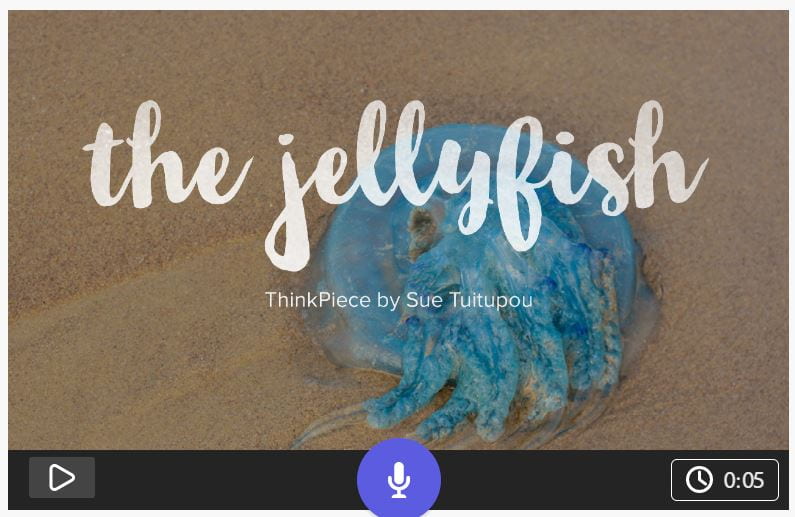
Innovator: Sue Tuitupou
LTQP: Katrina Cutcliffe
Initiative Summary:
Opportunity – To support First Nations pathways students
Pedagogy – 8 Ways
Tools – iSee, Padlet, Canva, and Adobe Express
Insight – Padlet was recognised for its alignment with First Nations pedagogies. It is completely inclusive. Adobe Express is an exemplary tool which easily facilitates storytelling and yarning.



Digital Learning Initiative Overview
Sue Tuitupou teaches both First Nations studies courses, and pathways courses within the College for First Nations, including Discover Your Deadly and the Indigenous Higher Education Pathways Program (IHEPP). Pathways programs draw First Nations students from diverse, and often remote, communities. Students have varied educational backgrounds: from school leavers to mature aged students; from those with positive educational experiences to those with little opportunity to access formal education; and from those who are highly digitally fluent, to those with little digital literacy.
Sue was motivated to start this Digital Learning Initiative (DLI) because she sought to use First Nations Pedagogies, specifically Dr Tyson Yunkaporta’s 8 Ways Learning Pedagogy Framework, to support her students as they transitioned into UniSQ.
Implementation
The 8 ways pedagogy guided the construction and implementation of selected tools.
Padlet
We used Padlet as a visually interesting tool to allow for the synchronous and asynchronous creation of community, yarning, and sharing. We explored the different types of Padlets and well as its multiple affordances.
As an example, our Map Padlet linked to the 8 Ways:
- Community links: Map Padlets connected people to their own community interactively, and asynchronously.
- Land links: Students were able to connect to country by marking on the map the place their family was connected to, and were able to see the connections of others’.
- Symbols: Students were able to select a symbol to represent to their connection to place and family.
- Story sharing: Students had a sense of pride in themselves as they were able to show others how their story connected to place (even though it is virtual).
Padlet was very successful as students were able to use the tool with great ease, which allowed them to feel confident sharing in the space. Students were keen to tell stories and share experiences on this platform. Sue has continued to use Padlet.
Canva
Canva was explored to facilitate the design of icons which were more representative of First Nations design, specifically through the use of circles.
Canvas design elements would allow for the facilitation of several of the 8 Ways:
- Non-linear: First Nations story-telling is non-linear and many of the visual design elements in First Nations artworks reflect this through the use of circles. Canva was used to create a circular image that reflected the circular nature of yarning circles.
- Non-verbal: Canva allowed for the creation of symbolic elements which could be used instead of verbal/textual elements that facilitated both denotative and connotative meaning.
- Learning maps: Though this function was not explored, it was hoped that learning maps could be developed within this tool.
Canva has multiple affordances and is capable of aligning with First Nations pedagogies and design elements, but it was found to be clunky with many of the template using squares instead of circular imagery. As tools like Padlet have many visual features, Sue will no longer be exploring Canva.
iSee
iSee if a virtual learning platform which allowed students to experience an ‘on country’ experience. The theme of the session was: body, mind, spirit, country, and past – how to expand on that story to make it future.
- Community Links: Yarning stories allowed students to connect through stories within a shared, virtual world. People could develop genuine connections with each other.
- Learning Maps: Students were able to experience their own country and share this experience with others. Learning could take place ‘on country’ yet virtually. Students who did not share the same geographical location, were still able to share the ‘on country’ experience.
- Non-verbal: Activities within the world allowed to contribute non-verbally. Thus, they were part of the process without feeling pressure to speak.
- Symbols and Images: The use of the message stick, when yarning, empowered students to respectfully contribute to the yarn when it was their turn to hold the message stick..
Sue has become inspired by the potential available within virtual learning environments. As a consequence, she is continuing to explore virtual learning environments through a TechDems Special Interest Group and hopes to innovate in this area in the future.
Adobe Express.
Adobe Express allowed Sue to create a ThinkPiece which was an interactive story that shared both her experiences and her pedagogy with others.
- Story-sharing and Community links: Everyone has a tale to tell. This tool allowed Sue to create stories that in turn prompted others to tell their own stories. This created community.
- Land links: Many yarns link to land. Sharing stories allows people to share their connections to land and thus encourage others to reflect upon their own connections.
- Deconstruct Reconstruct: The way the tool is constructed, users quickly understand what the final product might look like. It is already visually deconstructed for them. This then encourages them to construct their own video/story.
Sue found Adobe Express to be an excellent tool with high levels of intuitive usability. Everything was in one place, including the licensed images and music, which meant that videos could be created quickly and easily. The tool allows for genuine storytelling which can be facilitated through multiple mediums: text, images, voice, video, music …. Sue will continue to use it and encourage her students to do so as well.
What’s next?
Sue reflected:
“I learnt that First Nations pedagogy can be transferred online through many different tools and may appeal to a far wider audience in any setting, whether it be remotely, when on Country, or in a classroom.
My takeaway is that Online, Deadly First Nations’ Pedagogy does not have to be one size fits all. Instead any variation can be used as little or as much as the user chooses.
Another take away for using a First Nations pedagogy online is that the 8 Ways can be incorporated in various and multiple ways to connect and share, putting different ideas together and strengthening confidence in the user with the multitude of tools available.
I loved Padlet and how students could identify specific locations on the map and be connected to community, country and culture. My favourite tool was Adobe Express and having the ability to create a short interesting story with pictures, music and sound effects that students may identify with and in turn tell their own stories. I think Adobe Express has endless possibilities for students to use as in depth as they choose.
I will continue to use Adobe express and Padlet for Online First Nations Pedagogy.”


